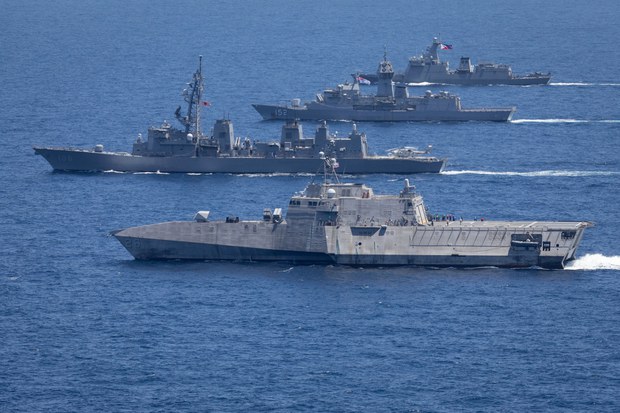China’s military conducted a naval and air patrol in the disputed South China Sea on Sunday – the same day the Philippines, US, Japan and Australia held joint drills.
“The Southern Theatre Command of the People’s Liberation Army will conduct a joint air and sea combat patrol in the South China Sea on April 7,” the Southern Theatre Command announced on its WeChat account on Sunday morning.
In what appeared to be a reference to the joint drills by the US and three other countries, the command said that military activities “intended to sabotage the situation” and create “hotspots” in the waters were “well under control”.
Do you have questions about the biggest topics and trends from around the world? Get the answers with SCMP Knowledge, our new platform of curated content with explainers, FAQs, analyses and infographics brought to you by our award-winning team.
The United States, Japan, Australia and the Philippines on Saturday announced they would stage a “maritime cooperative activity” on Sunday within what they called the “Philippine exclusive economic zone”.
It is the first full-scale exercise involving the four countries to demonstrate “collective commitment” to strengthening regional and international cooperation “in support of a free and open Indo-Pacific”, according to the joint statement.
According to the Philippine defence department, five warships will take part in the drills.
Two Philippine warships, the BRP Gregorio del Pilar and BRP Ramon Alcaraz, will join the drills alongside the American USS Mobile, Japan’s JS Akebono, and Australia’s HMAS Warramunga, according to the Japanese embassy in Manila.
The drills will include anti-submarine warfare training, tactical exercises, a link exercise and photo exercises, according to the Japanese embassy.
The joint drill comes amid growing tensions between Beijing and Manila over disputed waters in the South China Sea.
The Philippines has accused China of repeatedly obstructing resupply missions for the BRP Sierra Madre, a Philippine Navy transport ship that was intentionally grounded off the disputed Second Thomas Shoal, known as Renai Jiao in China. Beijing says the Philippine vessels entered its territory illegally.
Beijing and Manila have increasingly clashed over their competing claims to the South China Sea. Beijing claims a majority of the strategic waterway, which it delineates with a “nine-dash line”.
However, a 2016 ruling by an international tribunal rejected most of China’s claims within this U-shaped line. Beijing has rejected the ruling.
On March 23, three Philippine navy sailors were injured when Chinese coastguard personnel fired water cannons at their vessels. Manila also accused Chinese ships of conducting “dangerous” manoeuvres and blocking a civilian chartered resupply ship.
The Philippines and China traded accusations over an encounter off the Iroquois reef in the South China Sea on Saturday, when Philippine Coast Guard spokesman Jay Tarriela said China threatened fishermen with water cannons. Chinese coastguard spokesman Gan Yu maintained that Beijing’s handling of the incident was professional and said the Filipinos were conducting illegal activities.
In February, Beijing accused Manila of “roping in non-regional countries” – a veiled reference to the US – to stir trouble in the region as the two allies held a drill.
The Philippines has also held separate “maritime cooperative activities” with the US and Australia several times since last year.
In the Saturday statement, Philippine Defence Secretary Gilbert Teodoro said, “this first in a series of activities shows the enduring friendship and partnership” among the four countries.
US Defence Secretary Lloyd Austin said, the activities underscored the four countries’ “shared commitment to ensuring that all countries are free to fly, sail, and operate wherever international law allows.”
Philippine President Ferdinand Marcos Jnr is set to meet US President Joe Biden and Japanese Prime Minister Fumio Kishida in Washington on April 11. The agenda for that meeting will include planning for an agreement to improve the three countries’ interoperability and naval cooperation, Marcos said.
This article originally appeared in the South China Morning Post (SCMP), the most authoritative voice reporting on China and Asia for more than a century. For more SCMP stories, please explore the SCMP app or visit the SCMP’s Facebook and Twitter pages. Copyright © 2024 South China Morning Post Publishers Ltd. All rights reserved.

